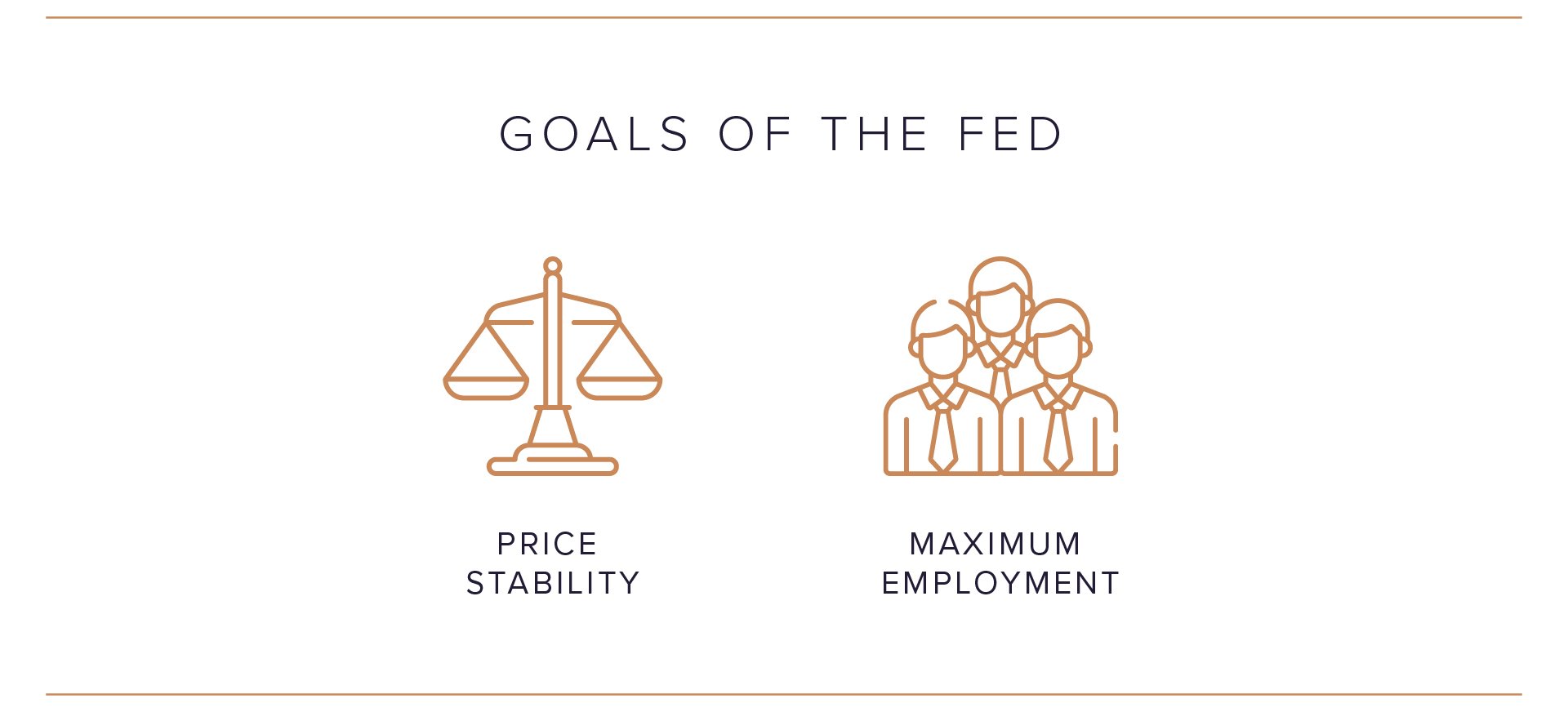If you paid attention to financial news at all last year, you would have likely seen a lot of coverage on how quickly interest rates are rising. Looking back to 2008 and coming out of the Great Financial Crisis, the federal funds target rate range has been near zero. Rates started to rise in 2017 until right before the COVID-19 pandemic hit when they decreased back to zero again in an attempt to keep the economy afloat.
The agency responsible for controlling the underlying rate increases and decreases is the Federal Reserve, also known as “The Fed”. The two main goals of the Fed are price stability and maximum employment. The Fed uses conventional tools like interest rate policy and unconventional tools such as quantitative easing and quantitative tightening in an effort to achieve those two goals.

In this article, I will explain what the Federal Reserve is and what they set out to do plus explain some of the lingo so you are able to understand what is going on when people are talking about the “Fed”, what they are doing now, and how it all may affect you.
What the Fed is.
The United States Federal Reserve, commonly known as the "Fed," is the central banking system of the United States. It was established on December 23rd, 1913, as part of the Federal Reserve Act of 1913 signed by President Woodrow Wilson. Congress does have the power to amend the Federal Reserve Act, and it has used those powers several times over the years.
12 regional banks make up the US Federal Reserve which are in various locations throughout the country. These regional banks are responsible for carrying out the policies of the Fed, and each has its own president who is voted on by banks within the region. That’s right. Banks within a region vote on the person who regulates them, for better or for worse.
It is led by a seven-member Board of Governors, which is appointed by the President and confirmed by the Senate. The current Chair of the Fed is Jerome Powell, who was appointed by former President Donald Trump in 2018.
The Federal Open Market Committee (FOMC) is a committee made up of the members of the Federal Reserve Board and the presidents of the Federal Reserve Banks. The FOMC is responsible for setting monetary policy in the United States. This includes setting the target range for the federal funds rate, which is the interest rate at which banks lend money to each other overnight. The federal funds rate also influences other interest rates in the US economy. The FOMC meets regularly to assess the current state of the economy and to make decisions about whether to raise, lower, or maintain the federal funds rate.
The Fed is an independent government agency, meaning that it operates without direct supervision from Congress or the President. This independence allows the Fed to make decisions based on what it believes is best for the economy, rather than being influenced by political considerations.
What the Fed does.
The Fed carries out five general responsibilities to provide the country with a stable, flexible, and safe monetary and financial system.
The Federal Reserve:
- Implements monetary policy by modifying money and credit conditions in the country to support maximum employment, stable prices, and moderate long-term interest rates.
- Encourages financial system stability and works to reduce and control systemic risks by actively monitoring and interacting in the US and overseas.
- Regulates and supports individual financial institutions' safety and soundness while keeping an eye on how they affect the entire financial system.
- Maintains the integrity and effectiveness of the payment and settlement systems by providing the banking industry and the U.S. government with services that enable transactions in U.S. dollars.
- Advocates for consumer protection and community development by focusing oversight and analysis on consumers as well as conducting research and evaluating emerging consumer challenges and trends, partaking in community economic development activities, and enforcing consumer laws and regulations.
Quantitative Easing vs. Quantitative Tightening
and Dovish vs. Hawkish.
Monetary policy includes setting interest rates and affecting the money supply. The Fed is seen as dovish if it is taking a more accommodative approach to monetary policy and hawkish if it is taking a more restrictive approach to monetary policy. A dovish stance is taken when the economy is facing economic challenges and a hawkish stance is taken when the economy is close to overheating.
When the Fed raises interest rates, it means that it is increasing the cost of borrowing money and the reward for saving it. This is a hawkish stance.
There are several reasons why the Fed might raise interest rates. One of the main reasons is to combat inflation. Inflation is the rate at which the prices of goods and services rise over time. If inflation gets too high, it can hurt the economy by making it more expensive for people to live. By raising interest rates, the Fed can help slow down inflation and keep it at a healthy level.
When the Fed lowers interest rates, it is attempting to have the opposite effect of when it raises interest rates. This is seen as taking a dovish stance. They are trying to decrease the cost of borrowing money and the reward for saving it. The Fed might begin to cut rates in order to encourage both people and businesses to spend money when they otherwise wouldn't have if it was more expensive to borrow or they earned more to save instead of spend. This action is usually taken when the economy isn't doing well.
When the Fed sells government securities on the open market to banks, it is decreasing the money supply. This is also known as quantitative tightening. Quantitative tightening is associated with a hawkish stance. This practice removes money from the banks' reserves, which they can no longer use to make loans to businesses and households. This decreases the overall amount of money in the economy and can help prevent inflation. The effect of this is like increasing interest rates. This is a powerful tool that can be used with other tools. This can lead to slowing inflation.
Quantitative easing is the opposite of quantitative tightening. It can be seen as associated with a dovish stance that involves the central bank buying large amounts of government securities, such as Treasury bonds, from banks and other financial institutions. This adds money to the banks' reserves, which they can then use to make loans to businesses and households. This increases the overall money supply and can help to stimulate economic growth. However, there are also some potential drawbacks and risks. For example, it can lead to inflation if not carefully managed.
Quantitative easing has only been used recently and was used when interest rates were already low and traditional monetary policy tools were no longer effective.
What is happening now?
Currently, The Fed is taking a hawkish stance in the sense that they are raising interest rates and they are also taking a hawkish stance regarding money supply as they are letting government securities run off the balance sheet. This is a drastically different stance than they have taken going back to 2008 as they were dovish and conducting copious amounts of quantitative easing.
.jpg?width=1920&height=465&name=104-183-SWM-Insights-Graphics-v2-03%20(1).jpg)
Will I notice increased rates?
Here are five specific examples of where you may see the increase in rates this year affect you:
- Increased return on cash via savings accounts, money market funds, etc.
- Increased cost of borrowing money for any purpose.
- New fixed-rate loans - mortgages, auto loans, personal loans, refinances
- New and existing variable rate loans - mortgages, home equity lines of credit, student loans, credit cards
- Decreased business spending due to increased cost of capital. When deciding whether to invest in a project, projects that were profitable two or three years ago may no longer be profitable. This leads to less spending on property, plant, and equipment and fewer jobs being created to produce whatever was going to be made from that project.
- Inflation beginning to cool down. You may notice the price of goods, services, and housing stabilize and stop increasing rapidly.
- Decreased government budget.
As always, we encourage you to contact your Sanderson financial adviser if you have any questions on the impact of the current market and economic forces on your portfolio.
Disclosure
© 2023 Sanderson Wealth Management LLC. This information is not intended to be and should not be treated as legal, investment, accounting or tax advice and is for informational purposes only. Readers, including professionals, should under no circumstances rely upon this information as a substitute for their own research or for obtaining specific legal, accounting, or tax advice from their own counsel. All information discussed herein is current as of the date appearing in this material and is subject to change at any time without notice. Opinions expressed are those of the author, do not necessarily reflect the opinions of Sanderson Wealth Management, and are subject to change without notice. The information has been obtained from sources believed to be reliable, but its accuracy and interpretation are not guaranteed.
Let’s talk about your future.
Schedule a consultation to learn more about our investment services.
Filter Blog Posts
SUBJECT
- Investment Consulting (158)
- Financial Planning (142)
- Tax Consulting (44)
- Estate & Generational Wealth Planning (15)
- Firm News (11)
- Lessons Earned (11)
- COVID-19: Market Watch (10)
- Community (4)
- Philanthropy (4)
- Business Succession Planning (3)
- Prosper Financial Wellness (3)
- Ukraine: Market Watch (1)
AUTHOR
- Angelo Goodenough
- C. Michael Bader, Esq., MBA, CPA, CIMA®
- Caleb Jennings, MBA, CFP®, CIMA®, AIF®
- Cameron Radziwon, LSSBB
- Debbie Todaro
- Evan Kraft, CFP®, CRPC®
- James Warner, MBA, CPA, CFP®, CIMA®
- Joe Bartelo, CPA
- John Gullo, MBA, CFA, CFP®, CIMA®
- John Sanderson, CPA, CIMA®
- Justin Sanderson, MBA, CFP®, CIMA®
- Karen Nicpon, CPA
- Phil Frattali, CFA
- Regyna Waterhouse
- Sanderson Wealth Management
- Tim Domino, CPA, CFP®
- Tucker Weppner, CFP®

